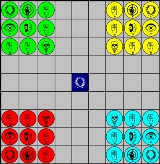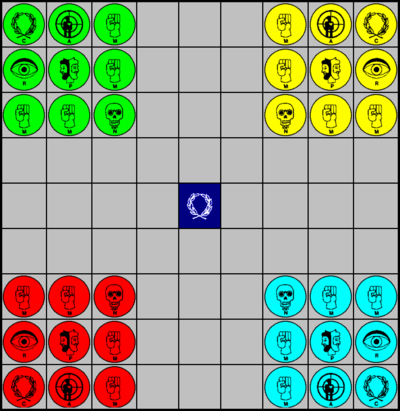
Djambi
Encyclopedia
Djambi is a board game
and a chess variant
for four players, invented by Jean Anesto in 1975.

whose central square (called "the maze") is marked with a different color or a sign. Each player has 9 pieces:
The troublemaker and the necromobile cannot kill the other pieces but can move them.
Board game
A board game is a game which involves counters or pieces being moved on a pre-marked surface or "board", according to a set of rules. Games may be based on pure strategy, chance or a mixture of the two, and usually have a goal which a player aims to achieve...
and a chess variant
Chess variant
A chess variant is a game related to, derived from or inspired by chess. The difference from chess might include one or more of the following:...
for four players, invented by Jean Anesto in 1975.

Material
The game is played on a 9×9 boardBoard game
A board game is a game which involves counters or pieces being moved on a pre-marked surface or "board", according to a set of rules. Games may be based on pure strategy, chance or a mixture of the two, and usually have a goal which a player aims to achieve...
whose central square (called "the maze") is marked with a different color or a sign. Each player has 9 pieces:
- 1 Chief
- 1 Assassin
- 1 Reporter
- 1 Troublemaker (also called Provocateur, or Diplomat)
- 1 Necromobile
- 4 Militants.
Objective
The objective of the game is to capture the chiefs of the other players before they capture yours. Although informal alliances can be temporarily agreed upon, there is no team: each player plays against the other players.Start position
The pieces are placed in each corner of the board as shown in the picture above.Movements
Each player, at his/her turn, moves one of his/her pieces, and can possibly capture a piece in this way. The militants move of one or two squares in the eight directions; the other pieces can move through any number of squares in the eight directions. A piece cannot jump above another piece.Captures
The pieces are "killed" as soon as they are captured, but their "corpses" stay on the board (the pieces are turned upside down to show that they are "dead"). The militant kills by occupying the square of a piece (capture by replacement). He places the corpse on an unoccupied square of his choice, except on the central square (the "maze"). A militant cannot kill a chief in power (see below).- the chief kills and places the corpse in the same way as the militant.
- the assassin kills in the same way as the militant, but places the corpse in the square he comes from.
- the reporter kills by occupying one of the four squares next to the square of the piece he wants to kill (he cannot kill diagonally). The corpse stays in his square. The reporter can only kill at the end of his move.
The troublemaker and the necromobile cannot kill the other pieces but can move them.
- the troublemaker can move another living piece by occupying its square (of course, he can only move the pieces of the other players). The piece is placed on any unoccupied square (except the maze if this piece is not a chief).
- the necromobile acts like a troublemaker but only with the dead pieces (whatever the origin of the dead piece is). The corpses cannot be placed in the maze.

